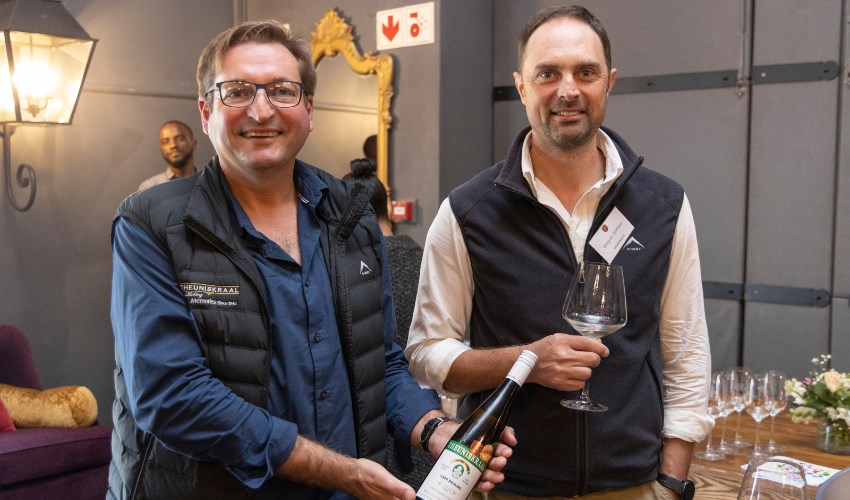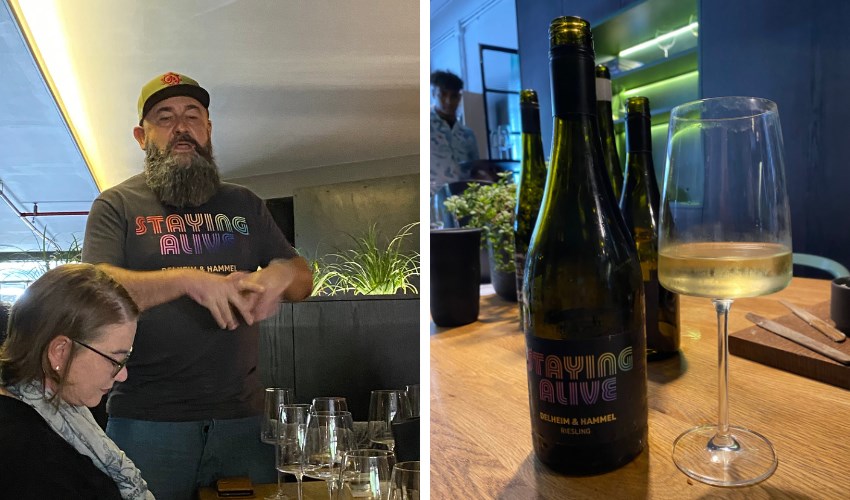Wine and food fashions are a fickle thing. Paging through early editions of Platter’s Wine Guide from the 1980s, you’ll come across dozens of entries of producers of Rhine (Weisser) Riesling and Cape Riesling (properly Crouchen Blanc) – as well as a new grape called Emerald Riesling making its first appearance in 1981. Scroll forward forty years and only two Cape Riesling wines – one a rarity labelled Crouchen Blanc by Monterosso, one labelled as Cape Riesling by Theuniskraal – are left standing alongside thirty producers of (Weisser or Rhine) Riesling.
In early June, I shared a table at Groot Constantia with the winemakers of Theuniskraal at the fiftieth anniversary of the first fourteen wine estates celebrating the inception of the wine of origin scheme in 1973. The third-generation family wine farm from Tulbagh is among the first fourteen – and bottled on estate a specially labelled edition of its iconic Cape Riesling 2023 (Crouchen Blanc) to mark the occasion. One of the Cape’s heritage wine brands, first released in 1948, Theuniskraal Cape Riesling celebrates it seventy-fifth vintage this year – the only producer still flying the rebel flag.

Winemakers stick to their guns around here. Family cellar master Andries Jordaan (since 1991) explained that his grandfather planted the first Crouchen Blanc on the Tulbagh farm (est. 1705) in the early 1940s – believing the vines were the real Riesling from the nursery. When the first wine was released under the Cape Riesling moniker, it won a gold medal at the Commonwealth Wine Show in London in 1950. It grew into one of South Africa’s iconic white wine brands – alongside Nederburg’s Paarl Riesling (also made from Crouchen Blanc). He says German critics mistake it as the real McCoy.
Crouchen Blanc, an obscure grape variety originating in the Western Pyrenees of France, was one of the early grapes planted in the Cape a few centuries ago. It has suffered a history of mislabelling since being re-exported from the Cape of Good Hope to Australia in the 1850s where it was confused with Semillon and known as Clare Riesling and Hunter Riesling for a century. According to Jancis Robinson’s Guide to Wine Grapes, ampelographer Paul Truel identified its true origins in 1976 – and label integrity programmes resulted in it being phased out as a variety in Australia. Since 1981, the Cape has not been able to export Cape Riesling – though it can still be sold within South Africa.
The oldest fruit-bearing vine in the southern hemisphere is reckoned to be Crouchen Blanc. Planted in 1771, this tenacious little vine survives in a quiet corner of the Cape Heritage Courtyard in downtown Cape Town – and sometimes produces twenty litres of wine in a good vintage. It has its very own plaque though most visitors heading to this bar and restaurant quarter pass it by.
So much for the synonyms. What does Theuniskraal Cape Riesling taste like? Refreshingly crisp, this aromatic light, dry white wine has grassy, floral aromas with a delightful bouquet of green apples, guavas and nectarines. Although its following has declined from its peak – when it was found on every hotel and restaurant wine-list in the country – it still has a dedicated following, playing on its nostalgic, retro image celebrated in the feel of the Theuniskraal website. Good value at R69 ex-farm.
Displaced in the 1990s by newer varieties such as Chardonnay and Sauvignon Blanc, Cape Riesling lost ground to the new trendy best-sellers. With the increased appeal of alternate varieties – and the search for diversity in the national vineyard – I wonder how it would sell if the label were changed to Crouchen Blanc instead of the synonym Cape Riesling? I suggested to Andries the wine might be labelled ironically as The Wrong Riesling. With a back story, it might appeal to retro hipsters.
Both true Riesling (0,14%) and Crouchen Blanc (0,21%) are declining minority players in the South African vineyard. While Elgin’s cool-climate terroir has produced some first-rate Riesling – led inter alia by Paul Clüver, Oak Valley, Spioenkop, and Cape Collective – Riesling has gone out of fashion. Or has it? In my rendezvous with Riesling in 2023, I also enjoyed a tasting of Delheim and Hammel’s new Staying Alive Riesling 2022 (a limited release at R375 per bottle) in March – presented alongside some of the newer, modern styles of Riesling from Germany. Riesling, it seems, is reinventing itself.
Christoph Hammel, the ninth-generation winemaker at Hammel wine estate (1723) in the Pfalz region,co-made the new Riesling with Delheim winemaker Roelof Lotriet. Hammel, a bearded hipster, is larger than life, a loud, irrepressible voice, forthright on the future shape of Riesling. "The modern German style of Riesling is clean, dry, fresh, lively and fruit-driven – good for food and petrol-free (the old character of those aged Riesling terpines). I try to make Riesling in a style that is a chart-breaker. Riesling is the new band on the stage. I want it to taste like the grape off the vine."
"Old-style aged Riesling is not hip anymore. As a vintner I don’t like ageability in Riesling. Even New Zealand which loves petrol in Riesling is changing. People want fruit-driven wine with minerality. There’s a lot of potential for Riesling in South Africa."
To emphasize the break with the past, Delheim Staying Alive Riesling, with its retro sixties label, is not bottled in a traditional Riesling bottle. "The great Riesling myth is that is must be off-dry, sweeter and taste like kerosene – old-style SA Riesling."

Hammel likes to talk about "the precision, stretchability and versatility" of Riesling – how there are 101 treatments and styles. He used lots of skin contact, concrete eggs and acacia barrels to make Delheim’s new Staying Alive Riesling 2022 fermented with a Swiss yeast isolated in 1895. Made from younger vines planted at an altitude of up to 340m in 2007, the new mach two Riesling demonstrates the winemaker’s mantra that Riesling – like Sauvignon Blanc – is slow-ripening and loves shadow not sun exposure. He believes that Delheim has the perfect mountainous conditions for growing Riesling.
Riesling is one of those varieties favoured by afficionados and wine critics: "The finest white wine grape in the world on the basis of the longevity of its wines and their ability to transmit the characteristics of a vineyard without losing Riesling’s own inimitable style" (Riesling advocate Jancis Robinson). Delheim has certainly excelled with its signature five-star Edelspatz Noble Late Harvest dessert wine with botrytis – made from the 239 clone planted in the office bloc way back in 1984.
If Delheim is refocusing on Riesling in the Simonsberg, Paul Clüver Family Wines is downplaying the variety in favour of Chardonnay and Pinot Noir as Elgin’s two signature grapes.
A few years ago I attended a marvellous tasting of Paul Cluver Riesling, including their iconic Woolworths Ferricrete (named after the rich koffieklip soils) Riesling, in the very vineyards where they were grown. It was a lesson in cool climate terroir. When I returned last year, the umlaut was back on the Paul Clüver wine label and I tasted three superb tiers of Chardonnay and Pinot Noir – but downsized to the single Village Riesling.
Over the years I’ve made my own Riesling pilgrimage to the Mosel in Germany, strolling up through steep vineyards to picturesque wine villages such as Bern-Kastel which are famous for expressions of the variety. I’ve tasted the Bernkasteler Doctor in situ from one of the most famous Riesling vineyards in the world. I’ve cycled the Riesling trail through the Clare Valley in South Australia, tasting my way through the famous Riesling cellars of the new world. Along the way I’ve visited nearby Eden Valley, renowned for its high-lying cool climate Riesling terroir – as well as Tasmania.
Riesling rules if you know where to find it. The great Riesling revival might still happen one of these days. Watch this space.